When the federal government shut down this fall, food banks across the country once again became the front line of response. From furloughed workers to families affected by SNAP benefit delays, need is rising, and communications teams are under pressure to respond with both urgency and care.
We’ve seen our food bank partners take quick, strategic action, not by reinventing their fundraising but by refining it. Here’s how they’re adapting messages and mobilizing donors while balancing tone, timing and trust.
1. Use the right tone
The shutdown is politically charged, which means tone matters more than ever.
Before creating anything new, food banks are asking a key question: Do we lean into the issue or stay above the politics?
Food Bank For New York City is taking a measured approach, adding a homepage banner and holding internal alignment meetings before going public with larger campaigns.
In the meantime, they hosted a federal employee food distribution in Queens that served 380 households and 1,347 people, garnering vast news coverage. They also published this video and sent an email on SNAP, which leveraged a 5X match.
Emergency response doesn’t need to consist of new and big ideas. Using the right tone and weaving that into smaller, one-off efforts can be just as powerful.
Houston Food Bank coordinated other efforts by hosting a press conference, creating a home page lightbox that offered and asked for help, running paid Facebook ads, featuring creative with urgent messaging and sending coordinated emails and texts to mobilize support.


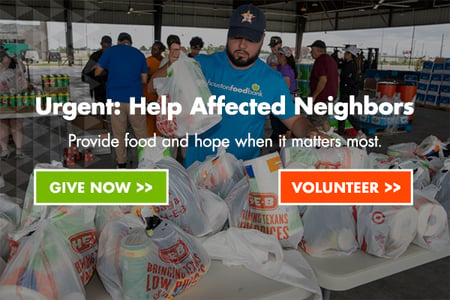
Both are effective because they’re intentional. Knowing your audience and using the right tone is a small but powerful way to move fast and still get it right. Nothing undermines trust faster than missing the mark.
2. Move fast with what you already have
In moments like this, food banks don’t need new scopes of work. They need to optimize existing assets.
How can you revamp what you already have?
- Update current messaging in active emails, landing pages and ads instead of building from scratch.
- Use pre-approved emergency templates that can be deployed within hours.
- Leverage tools already in use—lightboxes, CTAs, widgets and peer-to-peer and broadcast texting.
For example, St. Louis Area Foodbank first sent a standalone email and text. A few days later, they embedded a callout box about the shutdown into an existing campaign instead of launching a new appeal. The result: These assets raised up to $21,000.
.png?width=201&height=500&name=image%20(35).png)
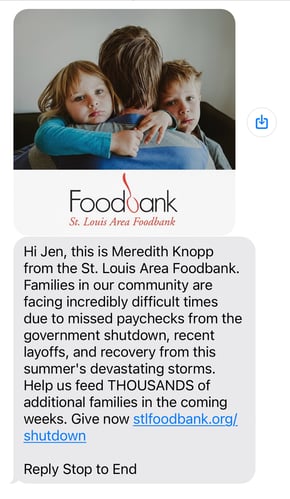
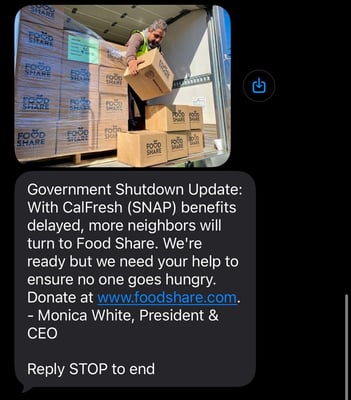 Similarly, Food Share of Ventura County kept it short and direct, skipping the usual formalities to focus immediately on the need. After receiving this text message, a donor visited the food bank with a $100,000 donation. By changing the message of an existing tool, they proved that brevity can still inspire action and enormous generosity.
Similarly, Food Share of Ventura County kept it short and direct, skipping the usual formalities to focus immediately on the need. After receiving this text message, a donor visited the food bank with a $100,000 donation. By changing the message of an existing tool, they proved that brevity can still inspire action and enormous generosity.
3. Keep fundraising and assistance connected
In every communication, food banks blend mission and message—ensuring that calls for help are paired with help for those in need. We’re seeing web traffic to some ‘Find Food’ and ‘Volunteer’ pages jump 200–300%. People are paying attention, so we need to meet them where they are.
Several clients have used dual-purpose homepage banners including CTAs for “Find food” and “Give help”—allowing web visitors easy access to what they are looking for.
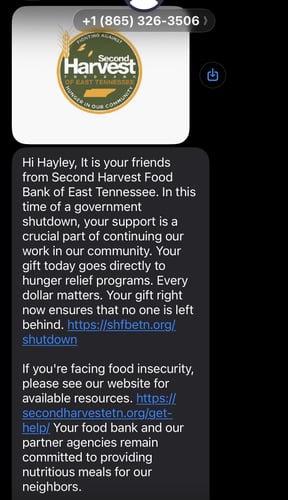 Second Harvest Food Bank of East Tennessee turned around a P2P text in under 24 hours that included two simple links: “Need help?” and “Want to help?” This format doubled engagement by reaching two critical audiences: those seeking assistance and those ready to give.
Second Harvest Food Bank of East Tennessee turned around a P2P text in under 24 hours that included two simple links: “Need help?” and “Want to help?” This format doubled engagement by reaching two critical audiences: those seeking assistance and those ready to give.
4. Align timing with key public moments
The shutdown coincides with major milestones that can help food banks time their outreach without feeling opportunistic.
Consider these dates for your planning efforts:
- Nov. 1: SNAP benefits run out in several states
- Nov. 11: Veterans Day—focus on vulnerable veterans
- Late Nov.: Thanksgiving travel and possibility for temporary federal budget deal
Adapting existing content instead of building new campaigns ensures urgency feels appropriate, not alarmist.
5. Plan for readiness—not reaction
The food banks that have moved fastest had one thing in common: They were prepared before crises hit. Now, others are following suit by cleaning house and building emergency readiness into their long-term strategy.
Action items we recommend:
- Audit digital assets and create or refine emergency templates.
- Update Google Business and Analytics to track traffic spikes to assistance pages.
- Use contingency or project budgets in existing scopes to fund rapid response needs.
Looking ahead
Even when the government reopens, the ripple effects won’t disappear overnight. Aftershocks will linger—from delayed paychecks to depleted pantries. Food banks that invest in agility now will be better positioned for whatever crisis comes next.
As we approach the season of gratitude and year’s end, we remember responsiveness isn’t about speed alone. It’s about readiness, relevance and respect for the moment.
For more resources, see how food banks are navigating funding cuts and how to communicate clearly during the government shutdown.



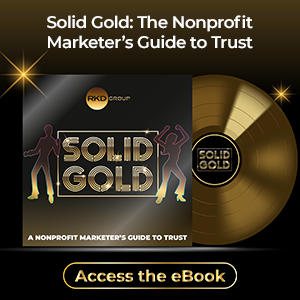
.png?width=2000&height=2000&name=image%20(30).png)

Leave a comment: